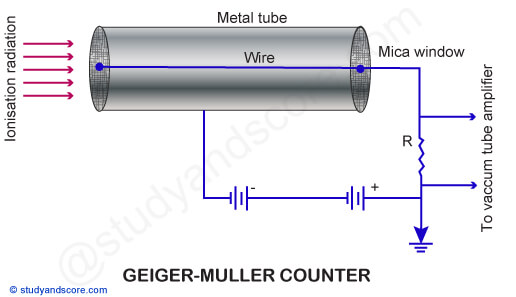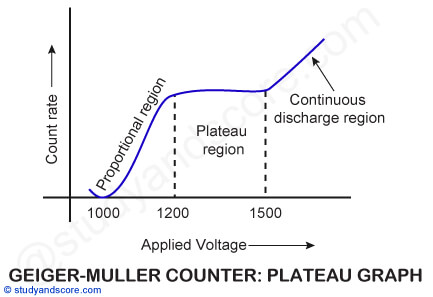When radioactive isotopes are used in medical research work particularly in human subjects it is very important that the amount of radioactive material given is as small as possible, in order that there should be minimum harmful radiations. Hence a very sensitive instrument is necessary to measure the radioactivity of materials.
Geiger and Muller developed a ‘Particle detector’ for measuring ‘ionizing radiation’ in 1928. They named it as ‘Geiger Muller Counter’. Ever since then it has been one of the most widely used nuclear detectors in the developmental days of Nuclear physics. The particle detector developed by Geiger and Muller is a gas filled counter. The main difference between ‘proportional counter’ and ‘Geiger-Muller Counter’ is in the formation of the avalanche. In the proportional counter, the avalanche is formed only at a point whereas in Geiger-Muller Counter it is formed in the central wire. Therefore, in GM Counter amplification is independent of initial ionization produced by the ionizing particle.
Geiger counter is also called as Geiger tube. This instrument is actually used for detecting and measuring ionizing radiation like alpha particles, beta particles, and gamma rays. A Geiger-Müller counter can count individual particles at rates up to about 10,000 per second and is used widely in medicine and in prospecting for radioactive ores.
The basic principle of the Geiger Muller counter can be understood as follows. When an ionizing particle passes through the gas in an ionizing chamber, it produces a few ions. If the applied potential difference is strong enough, these ions will produce a secondary ion avalanche whose total effect will be proportional to the energy associated with the primary ionizing event.
If the applied potential difference is very high, the secondary ionization phenomenon becomes so dominant that the primary ionizing event loses its importance. In other words, the size of the final pulse produced depends only on the triggering off of ionization by an ionizing particle but independent of the energy of this particle.
A high energy particle entering through the mica window will cause one or more of the argon atoms to ionize. The electrons and ions of argon thus produced cause other argon atoms to ionize in a cascade effect. The result of this one event is sudden, massive electrical discharge that causes a current pulse. The current through R produces a voltage pulse of the order of 10μV. An electron pulse amplifier accepts the small pulse voltage and amplifies them to about 5 to 50 V. The amplified output is then applied to a counter. As each incoming particle produces a pulse, the number of incoming particles can be counted.

The tube is filled with Argon gas, and around voltage of +400 Volts is applied to the thin wire in the middle. When a particle arrives into the tube, it takes an electron from Argon atom. The electron is attracted to the central wire and as it rushes towards the wire, the electron will knock other electrons from Argon atoms, causing an "avalanche". Thus one single incoming particle will cause many electrons to arrive at the wire, creating a pulse which can be amplified and counted. This gives us a very sensitive detector.
There is a threshold below which the tube doesn’t work. This can be several hundred volts. After this, the number of pulses is proportional to the voltage. This region is known as proportional region.
If the applied voltage is increased further, then a point will be reached after which the count rate remains constant over a certain region. This region is known as plateau region or Geiger region. This region is used for Geiger Muller operation.
Beyond the plateau region the applied electric field is so high that a continuous discharge takes place in the tube and the count rate increases very rapidly. It does not require any ionization event to happen so that the tube must not be used in this region.

The Geiger Muller counter can account for about 500 particles per second. The GM counter will not register those particles that pass through it in the dead time. Dead time refers to the time taken by the tube to recover between counts. It requires about 200 μs for the tube to recover. If lot of particles enter the GM tube at a rapid rate, the tube will not have time to recover and some particles may not be counted.
The efficiency of the counter is defined as the ration of the observed counts per second to the number of ionizing particles entering the counter per second. Counting efficiency is defined as the ability of counting of the GM counter.
|
Counting efficiency, η = 1- exp (spl) Where, s = specific ionization at one atmosphere p= pressure in atmosphere l = path length of the ionization particle in the counter |
Geiger counters have many applications in radioactivity detection. Here are few of the examples:
|
It is important to note that Geiger-Muller counter does not detect the following,
|
Hope you have liked this post.
Please share it with your friends through below links.
All the very best from Team Studyandscore
“Study well, Score more…”
- Share with your friends! -
Login to post your comment here...
- or with social Account -